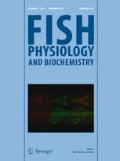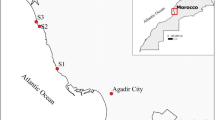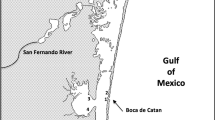Abstract
In the present study, multibiomarker effects of the river water of three representative sections in Nanjing section of the Yangtze River were investigated in goldfish (Carassius auratus). The organic toxicants were extracted from the water samples using solid phase extraction. Acetylcholinesterase (AChE), glutathione-S-transferase (GST), 7-ethoxyresorufin-O-deethylase (EROD), glutathione peroxidase (GPx) and Na+/K+-ATPase activities were determined after exposure of the extracted components. The fractions of water samples from three sections (Daqiao, Sanchahe and Jiangxinzhou) altered these enzymatic activities. With the change of the extracts polarity, the levels of AChE, GST, EROD, Na+/K+-ATPase activities were different. The responses of enzymatic activities were mostly significant for those exposures of intermediate polar components (50–80% methanol extracts) and weakly polar components (ether and ether/hexane extracts). It has been shown that toxicants were mainly concentrated in these fractions in the Yangtze River (Nanjing section). With regard to response for different sections, EROD and GST activities seem to be more sensitive biomarkers. Integrated biomarker response index (IBR) were calculated and used to evaluate an integrated impact of pollutants from different sampling sections. The order of negative biological effects of the three sections was Jiangxinzhou > Sanchahe > Daqiao. The wild fish living in Nanjing section of the Yangtze River were at potential ecological risk.








Similar content being viewed by others
References
Aarab N, Champeau O, Mora P, Daubeze M, Garrigues P, Narbonne JF (2004) Scoring approach based on fish biomarkers applied to French river monitoring. Biomarkers 9:258–270
Beliaeff B, Burgeot T (2002) Integrated biomarker response: a useful tool for ecological risk assessment. Environ Toxicol Chem 21:1316–1322
Berntssen MHG, Aatland A, Handy RD (2003) Chronic dietary mercury exposure causes oxidative stress, brain lesions, and altered behaviour in Atlantic salmon (Salmo salar) parr. Aquat Toxicol 65:55–72
Bocquené G, Chantereau S, Clérendeau C, Beausir E, Ménard D, Raffin B, Minier C, Burgeot T, Leszkowicz AP, Narbonne J-F (2004) Biological effects of the “Erika” oil spill on the common mussel (Mytilus edulis). Aquat Living Resour 17:309–316
Bradford M (1976) A rapid and sensitive method for quantification of microgram quantities of protein utilizing the principle dye binding. Anal Biochem 72:248–254
Broeg K, Lehtonen KK (2006) Indices for the assessment of environmental pollution of the Baltic Sea coasts: integrated assessment of a multi-biomarker approach. Mar Pollut Bull 53:508–522
Chèvre N, Gagné F, Blaise C (2003) Development of a biomarker-based index for assessing the ecotoxic potential of aquatic sites. Biomarkers 8:287–298
Costa LG (1996) Biomarker research in neurotoxicology: the role of mechanistic studies to bridge the gap between the laboratory and epidemiological investigations. Environ Health Perspect 104:55–67
Damiens G, Gnassia-Barelli M, Loqués F, Roméo M, Salbert V (2007) Integrated biomarker response index as a useful tool for environmental assessment evaluated using transplanted mussels. Chemosphere 66:574–583
de la Torre FR, Salibián A, Ferrari L (2007) Assessment of the pollution impact on biomarkers of effect of a freshwater fish. Chemosphere 68:1582–1590
Desbrow C, Routledge EJ, Brighty GC, Sumpter JP, Waldock M (1998) Identification of estrogenic chemicals in STW effluent. 1. chemical fractionation and in vitro biological screening. Environ Sci Technol 32:1549–1558
Dutta HM, Arends DA (2003) Effects of endosulfan on brain acetylcholinesterase activity in juvenile bluegill sunfish. Environ Res 91:157–162
Ellman GL, Courtney D, Andres VJ, Featherstone RM (1961) A new and rapid colorimetric determination of acetylcholinesterase activity. Biochem Pharmacol 7:88–95
Elskus AA (2004) Estradiol and estriol suppress CYP1A expression in rainbow trout primary hepatocytes. Mar Environ Res 58:463–467
Fatima M, Ahmad I, Sayeed I, Athar M, Raisuddin S (2000) Pollutant-induced over-activation of phagocytes is concomitantly associated with peroxidative damage in fish tissues. Aquat Toxicol 49:243–250
Frasco MF, Guilhermino L (2002) Effects of dimethoate and beta-naphthoflavone on selected biomarkers of Poecilia reticulata. Fish Physiol Biochem 26:149–156
Grue CE, Gibert PL, Seeley ME (1997) Neurophysiological and behavioral changes in non-target wildlife exposed to organophosphate and carbamate pesticide: thermoregulation, food consumption and reproduction. Amer Zool 37:369–388
Guilhermino L, Lopes MC, Carvalho AP, Soares AMVM (1996) Inhibition of acetylcholinesterase activity as effect criterion in acute tests with juvenile Daphnia magna. Chemosphere 32:727–738
Gulick AM, Fahl WE (1995) Mammalian glutathione-S-transferase: regulation of enzyme system to achieve chemotherapeutic efficacy. Pharmacol Ther 66:237–257
Habig WH, Jakoby WB (1981) Assays for differentiation of glutathione S-transferases. Methods Enzymol 77:398–405
Hugla JL, Thomé JP (1999) Effects of polychlorinated biphenyls on liver ultrastructure, hepatic monooxygenases, and reproductive success in the barbel. Ecotoxicol Environ Saf 42:256–273
Lagadic L, Caquet T, Amiard JC, Ramade F (2000) Use of biomarkers for environmental quality assessment. Laviosier, Paris
Lakshmi R, Kundu R, Mansuri AP (1990) Toxicity of mercury to mudskipper Boleophthalmus dentatus (Cuvand Val.): part I changes in the activity of ATPase in gills. Acta Hydrochim Hydroobiol 18:605–611
Li SN, Xie XC, Tan YJ, Zhu GN (2005) Induction of triazophos to brain acetylcholinesterase from topmouth gudgeon, Pseudorasbora parva. Chinese J Pestic Sci 7:59–62
Li Y, Wu Y, Chen Y, Kong Z (2006) Genotoxicity evaluation and a primary risk assessment of organic pollutants in the drinking water sources of Nanjing, China. J Environ Sci 18:983–988
Lu GH, Wang C, Zhu Z (2009) The dose–response relationships for EROD and GST induced by polyaromatic hydrocarbons in Carassius auratus. Bull Environ Contam Toxicol 82:194–199
Masfaraud JF, Devaux A, Pfohl-Leszkowicz A, Malaveille C, Monod G (1992) DNA adduct formation and 7-ethoxyresorufin O-deethylase induction in primary culture of rainbow trout hepatocytes exposed to benzo[a]pyrene. Toxic in Vitro 6:523–531
Navas JM, Segner H (2000) Modulation of trout 7-ethoxyresorufin-O-deethylase (EROD) activity by estradiol and octylphenol. Mar Environ Res 50:157–162
Paxton R, Umminger BL (1983) Altered activities of branchial and renal Na/K- and Mg-ATPase in cold-acclimated goldfish (Carassius auratus). Comp Biochem Physiol Part B 74:503–506
Richardson BJ, Sharon BDL, McClellan MMK, Lam PKS (2008) Antioxidant responses to polycyclic aromatic hydrocarbons and organochlorine pesticides in green-lipped mussels (Perna viridis): do mussels integrate biomarker responses? Mar Pollut Bull 57:321–328
Song W, Lu G, Li X, Zhang H, Qin J (2009) Characters of environmental estrogen pollution in Yangtze River (Nanjing section). Ecol Environ Sci 18:1615–1619
Stephensen E, Adolfsson-Erici M, Celander M, Hulander M, Parkkonen J, Hegelund T, Sturve J, Hasselberg L, Bengtsson M, Förlin L (2003) Biomarker responses and chemical analyses in fish indicate leakage of polycyclic aromatic hydrocarbons and other compounds from car tire rubber. Environ Toxicol Chem 22:2926–2931
Stien X, Percic P, Gnassia-Barelli M, Romeo M, Lafaurie M (1998) Evaluation of biomarkers in caged fishes and mussels to assess the quality of waters in a bay of the NW Mediterranean Sea. Environ Pollut 99:339–345
Sun C, Dong Y, Xu S, Yao S, Dai J, Han S, Wang L (2002) Trace analysis of dissolved polychlorinated organic compounds in the water of the Yangtse River (Nanjing, China). Environ Pollut 117:9–14
Tejeda-Vera R, López-López E, Sedeño-Díaz JE (2007) Biomarkers and bioindicators of the health condition of Ameca splendens and Goodea atripinnis (Pisces: Goodeaidae) in the Ameca River, Mexico. Environ Int 33:521–531
van der Oost R, Beyer J, Vermeulen NPE (2003) Fish bioaccumulation and biomarkers in environmental risk assessment: a review. Environ Toxicol Pharmacol 13:57–149
Wang C, Lu GH, Cui J, Wang PF (2009) Sublethal effects of pesticide mixtures on selected biomarkers of Carassius auratus. Environ Toxicol Pharmacol 28:414–419
Wendelaar Bonga SE (1997) The stress response in fish. Physiol Revs 77:591–625
Wu B, Zhao D, Zhang Y, Zhang X, Cheng S (2009) Multivariate statistical study of organic pollutants in Nanjing reach of Yangtze river. J Hazard Mater 169:1093–1098
Zhang J, Shen H, Wang X, Wu J, Xue Y (2004) Effects of chronic exposure of 2,4-dichlorophenol on the antioxidant system in liver of freshwater fish Carassius auratus. Chemosphere 55:167–174
Acknowledgments
This research was funded by China’s National Basic Research Program (2008CB418203) and Key Project of Chinese Ministry of Education (109076).
Author information
Authors and Affiliations
Corresponding author
Rights and permissions
About this article
Cite this article
Wang, C., Lu, G.H., Song, W.T. et al. Integrated biomarker response index for the assessment of environmental stress of the Yangtze River (Nanjing section). Fish Physiol Biochem 36, 1069–1078 (2010). https://doi.org/10.1007/s10695-010-9384-9
Received:
Accepted:
Published:
Issue Date:
DOI: https://doi.org/10.1007/s10695-010-9384-9




